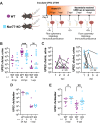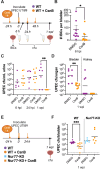Nur77 protects the bladder urothelium from intracellular bacterial infection
- PMID: 39333075
- PMCID: PMC11436794
- DOI: 10.1038/s41467-024-52454-8
Nur77 protects the bladder urothelium from intracellular bacterial infection
Abstract
Intracellular infections by Gram-negative bacteria are a significant global health threat. The nuclear receptor Nur77 (also called TR3, NGFI-B, or NR4A1) was recently shown to sense cytosolic bacterial lipopolysaccharide (LPS). However, the potential role for Nur77 in controlling intracellular bacterial infection has not been examined. Here we show that Nur77 protects against intracellular infection in the bladder by uropathogenic Escherichia coli (UPEC), the leading cause of urinary tract infections (UTI). Nur77 deficiency in mice promotes the formation of UPEC intracellular bacterial communities (IBCs) in the cells lining the bladder lumen, leading to persistent infection in bladder tissue. Conversely, treatment with a small-molecule Nur77 agonist, cytosporone B, inhibits invasion and enhances the expulsion of UPEC from human urothelial cells in vitro, and significantly reduces UPEC IBC formation and bladder infection in mice. Our findings reveal a new role for Nur77 in control of bacterial infection and suggest that pharmacologic agonism of Nur77 function may represent a promising antibiotic-sparing therapeutic approach for UTI.
© 2024. The Author(s).
Conflict of interest statement
The authors declare no competing interests.
Figures







Similar articles
-
A non-canonical autophagy-dependent role of the ATG16L1T300A variant in urothelial vesicular trafficking and uropathogenic Escherichia coli persistence.Autophagy. 2019 Mar;15(3):527-542. doi: 10.1080/15548627.2018.1535290. Epub 2018 Nov 8. Autophagy. 2019. PMID: 30335568 Free PMC article.
-
Surfactant protein D inhibits adherence of uropathogenic Escherichia coli to the bladder epithelial cells and the bacterium-induced cytotoxicity: a possible function in urinary tract.J Biol Chem. 2012 Nov 16;287(47):39578-88. doi: 10.1074/jbc.M112.380287. Epub 2012 Sep 25. J Biol Chem. 2012. PMID: 23012359 Free PMC article.
-
Detection of intracellular bacterial communities in human urinary tract infection.PLoS Med. 2007 Dec;4(12):e329. doi: 10.1371/journal.pmed.0040329. PLoS Med. 2007. PMID: 18092884 Free PMC article.
-
NRF2 promotes urothelial cell response to bacterial infection by regulating reactive oxygen species and RAB27B expression.Cell Rep. 2021 Oct 19;37(3):109856. doi: 10.1016/j.celrep.2021.109856. Cell Rep. 2021. PMID: 34686330
-
Host-pathogen checkpoints and population bottlenecks in persistent and intracellular uropathogenic Escherichia coli bladder infection.FEMS Microbiol Rev. 2012 May;36(3):616-48. doi: 10.1111/j.1574-6976.2012.00339.x. FEMS Microbiol Rev. 2012. PMID: 22404313 Free PMC article. Review.
References
-
- Foxman, B. Urinary tract infection syndromes: occurrence, recurrence, bacteriology, risk factors, and disease burden. Infect. Dis. Clin. North Am.28, 1–13 (2014). - PubMed
-
- Foxman, B. Epidemiology of urinary tract infections: incidence, morbidity, and economic costs. Am. J. Med.113, 5S–13S (2002). - PubMed
-
- Foxman, B. et al. Risk factors for second urinary tract infection among college women. Am. J. Epidemiol.151, 1194–1205 (2000). - PubMed
-
- Craig, J. C. et al. Prevention of recurrent urinary tract infection in children with vesicoureteric reflux and normal renal tracts (PRIVENT) investigators, antibiotic prophylaxis and recurrent urinary tract infection in children. New Engl. J. Med.361, 1748–1759 (2009). - PubMed
-
- Anger, J. et al. Recurrent uncomplicated urinary tract infections in women: AUA/CUA/SUFU guideline. J. Urol.202, 282–289 (2019). - PubMed
Publication types
MeSH terms
Substances
Grants and funding
LinkOut - more resources
Full Text Sources
Medical
Molecular Biology Databases

